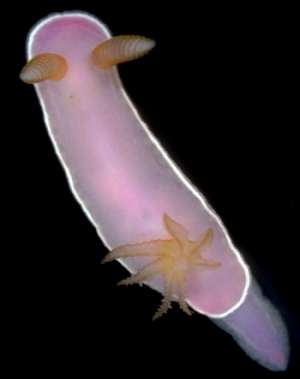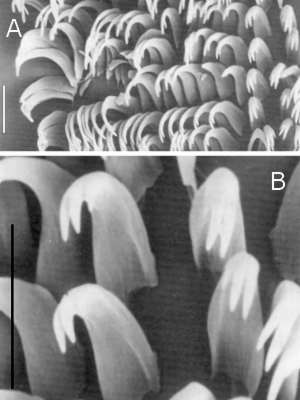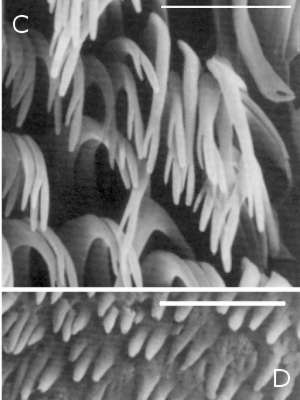
Durvilledoris albofimbria
Rudman, 1995
Order: NUDIBRANCHIA
Suborder: DORIDINA
Superfamily: EUDORIDOIDEA
Family: Chromodorididae
DISTRIBUTION
New Caledonia
PHOTO
Upper: Channel, Passe de Koumac, 20 40.7'S, 164 14.7'E, 66-87m, dredged in mixed shell sand and mud, NW New Caledonia, Holotype, 11mm long alive, 24 October 1993, AM C200617 (in MNHN, Paris). Photo: Bill Rudman. Lower: SEM photos of radula.
The mantle is translucent pink, with a deeper pink arc around the anterior end. The edge of the mantle is translucent clear, but just inside is a narrow band of bright opaque white. Visible through the transparency of the mantle edge are a row of translucent whitish spherical mantle glands. The body and foot are translucent pink, with a slightly purple tinge at the posterior end. There is a broad translucent clear band around the edge of the foot. The rhinophore stalk is translucent with a distinct orange tinge, and the rhinophore club is also translucent clear in the basal half, but in the upper half the core is opaque white. The lamellae are tinged with orange giving the whole rhinophore a watery orange coloration. The gills are also translucent clear but they are edged with a washy orange line.
The mantle is elongately oval, with a distinct but not greatly developed or folded mantle skirt. The mantle glands consist of single spheres arranged around the mantle edge. They are quite closely packed and around the anterior and posterior ends they become larger and more closely packed. There are seven simple gills forming an arch around the anal papilla. The gills are not vibratile. The radual formula was 18.0.18 x 35. The innermost lateral teeth are tricuspid, and the other lateral teeth are hook-shaped and elongate with a bifid tip. This species has anatomical similarities to both Thorunna and Durvilledoris, but the mantle glands and the non-vibratile gills are two features favouring its placement in Durvilledoris.
In colour and shape it is almost identical to Thorunna punicea, which was found at the same location. The only obvious external difference was that in T. punicea the gills are vibratile.
-
Rudman, W.B. (1995) The Chromodorididae (Opisthobranchia: Mollusca) of the Indo-West Pacific: further species from New Caledonia and the Noumea romeri colour group. Molluscan Research, 16: 1-43.
PHOTOS: SEM photos of radula. A, Section of radula showing central region and left side; B, central region showing innermost right and left lateral teeth; C, mid-lateral teeth on left side; D, jaw rodlets. Scale bars: A-C = 20 µm; D = 10 µm. Photo: A.C. Miller.


Rudman, W.B., 2005 (January 31) Durvilledoris albofimbria Rudman, 1995. [In] Sea Slug Forum. Australian Museum, Sydney. Available from http://www.seaslugforum.net/factsheet/durvalbo
